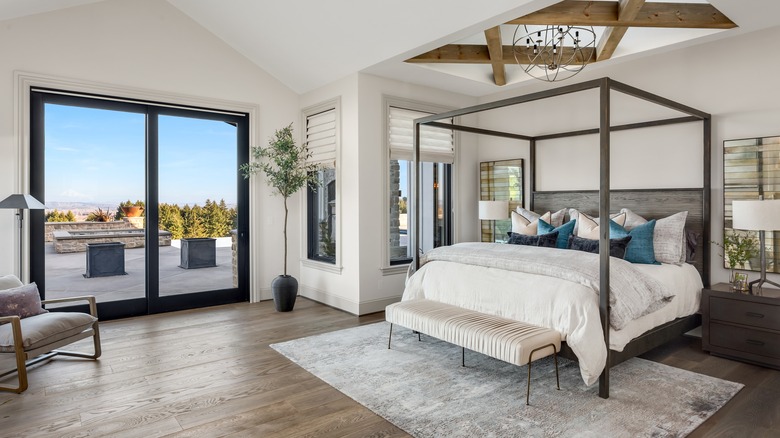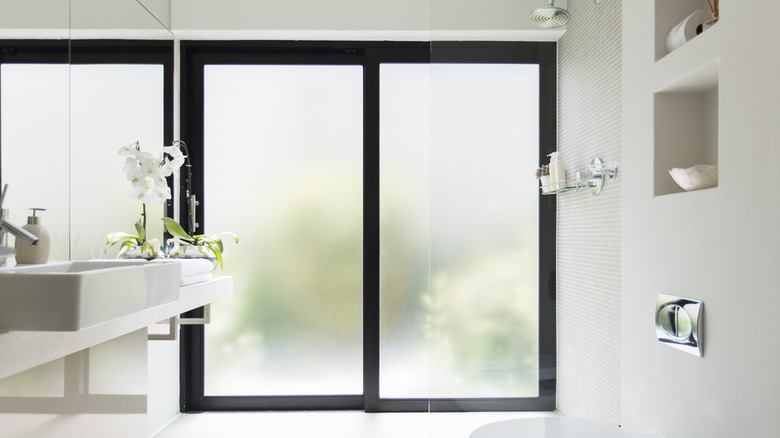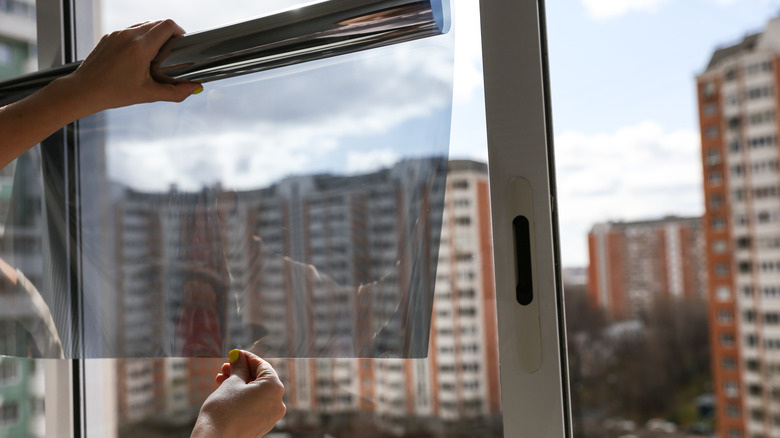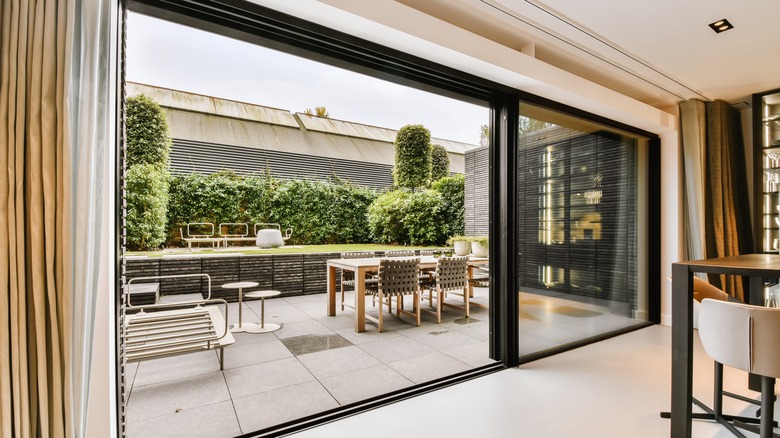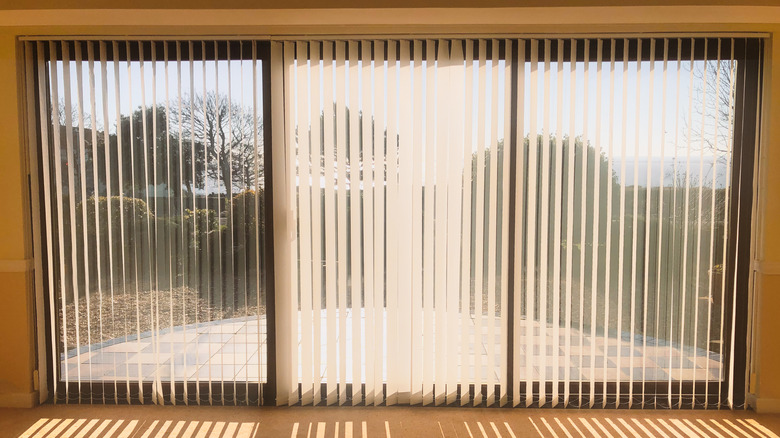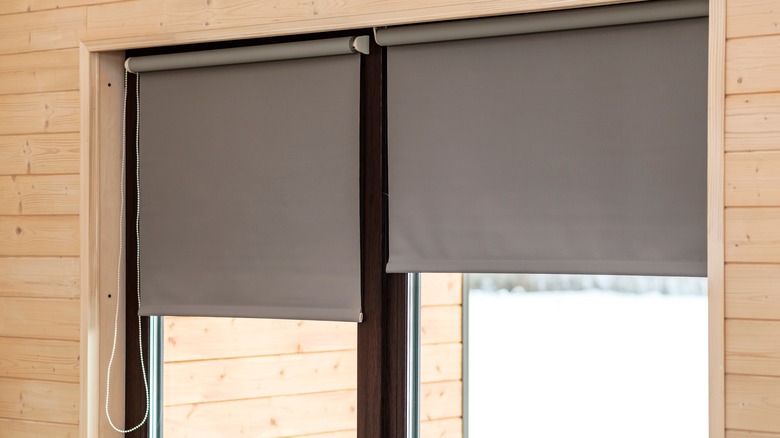How To Create More Privacy If You Have Glass Doors
Glass doors are a convenient way to bring some extra light into a space if you don't have a lot of room for windows. However, installing floor-to-ceiling glass has some drawbacks when creating an intimate feel in your room. Many people who move into a home with existing glass doors are worried about an increased chance of burglaries, but thankfully, this design choice doesn't directly impact the chances of a break-in. With that being said, however, it can still make you a bit uncomfortable if you feel you're providing your neighbors a first-hand glance into the inside of your home. The solution to this problem lies primarily in classic window treatments that can still function on and around a door.
Certain blinds, curtains, and window films are better suited for this purpose than others. Still, there are plenty of options available on the market that allow you to cater your selections to your existing décor and specific situation. After you determine what's best for you, you'll be able to capitalize on the added boost of natural light glass doors provided during the day while still feeling secure and comfortable at night.
Consider frosted glass
This first option is one of the simplest and lowest-profile solutions available. If you're installing your glass doors yourself, or if you're willing to swap them out for an upgrade, consider frosted glass instead of the typical crystal-clear choice. Frosted glass is a type of glass that has been treated with either acid or sandblasting. This texturization creates a large number of tiny scratches on the surface, which obscures the image behind it and creates a more private feel while still allowing light in.
Frosted glass is an excellent choice for areas where you don't have the ability to install curtains, want to create a minimalistic look, or desire more privacy throughout the day. The downside is that you can't remove this treatment if you want to look outside, but it can be a great choice for areas like the bathroom where you want to consistently avoid feeling exposed.
Try a window film
If you like the idea of something more permanent and low-profile like frosted glass, but you can't completely swap your existing glass, consider looking into window film. This treatment essentially works like tinting your car's windows or installing a screen protector on your phone. A thin sheet of plastic is layered over your existing glass, allowing you to slightly or fully obscure the image behind it.
In recent years, window film has risen in popularity, and, as a result, the number of options available has skyrocketed. The reflective, one-way film is a classic option that allows you to see out but doesn't allow people outdoors to see in, but there are also faux stained glass, kaleidoscopic, and texturized glass options available. This rental-friendly DIY is also typically more cost-effective than other window treatments. However, it does take a bit of finesse to properly install on your own without creating any bubbles or gaps in the final product.
Install curtains
Sometimes, the simplest solution is also the best solution. If you want the best of both worlds — bright sunshine and visibility during the day and darkness and privacy at night — curtains are one of the easiest-to-install and most flexible options. Install a curtain rod that extends slightly past your glass doors, then get to work choosing the perfect curtains for your space. This extra room will allow you access to your door handles and locks while your curtains are open but still conceal the entire door to block out light and create more privacy while they're closed.
Curtains are a perfect option if you have glass doors in your bedroom. Our bodies run on a natural circadian rhythm that follows the sun, so excess light in the early hours of the morning or headlights from passing cars at night can disrupt your sleep. Blinds can help reduce the impacts of this light. Still, blackout curtains can completely block it out, allowing you to rest more deeply and reduce the negative effects of sleep deprivation or insomnia.
Stick to the basics with vertical blinds
If your house or apartment is slightly older, you likely already have vertical blinds or a track to install blades yourself. Vertical blinds are one of the most common window treatment types for a reason — they're simplistic, easily take up a large amount of space, and can be fully pulled back to reveal the entire view from the window. The problem, however, is that the blades are loud, often flimsy, and notorious for breaking or getting caught on the track.
To combat this, consider replacing your existing slats with something a bit sturdier, like an option covered in fabric like these Vertical Fabric Blinds from Levolor. This way, you'll get the same functionality and easy installation without the annoying breakage and noise. Slightly upgraded varieties of these blinds are typically a bit more expensive, but if you have an existing track set up, the switch is much more cost-effective than completely swapping the style.
Try out shades
Shades are one of the more common window treatments, but they can also block light and provide better privacy if you have glass doors. The exact style will depend on how your glass doors were installed, but hanging a shade from the frame can offer a simple and sleek solution that still gives you plenty of flexibility. Styles range from paper-thin pleated shades to opaque fabric shades that completely block out any sun, so there are different options for how much privacy you want and how much light you plan to let in.
If you have sliding glass doors, this might not be the best choice for you, as this style looks the best when it can sit flush with the glass. For French doors or a regular glass door that opens on a hinge, however, this is a solid choice that offers quite a bit of flexibility when it comes to the final look.
